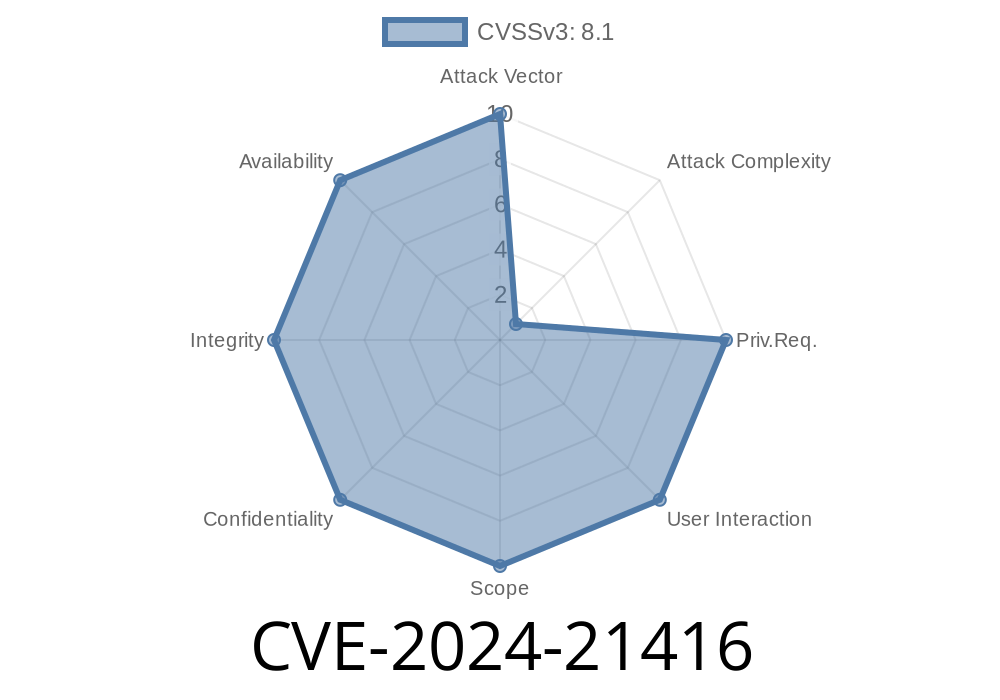In this long read, we will be going into an extensive analysis of a critical Windows operating system vulnerability identified as CVE-2024-21416. This vulnerability is a potentially harmful flaw in the Windows TCP/IP stack, which, if exploited, could lead to unauthorized remote code execution on affected systems. We'll be taking a close look at the features of the exploit, examining the original references and vulnerable code, and discussing how to mitigate the potential impact of this vulnerability.
Before we delve into the details of this exploit, let's first discuss the basic terminology associated with these kinds of vulnerabilities.
CVE (Common Vulnerabilities and Exposures) is a comprehensive list of publicly known security vulnerabilities. The CVE-2024-21416 identifier is an assigned code that serves as a reference to this specific Windows TCP/IP vulnerability.
TCP/IP (Transmission Control Protocol/Internet Protocol) is a set of protocols used for communication over a network. It is the standard way through which data packets are sent and received online, and a cornerstone of the modern connected world.
Remote Code Execution (RCE) is when an attacker can execute arbitrary code on a victim's system, often without the victim's knowledge or consent. This can result in severe consequences, such as unauthorized access, data theft, or compromised system integrity.
Now that we've covered the basics let's dive into the details of CVE-2024-21416.
Vulnerability Overview
CVE-2024-21416 pertains to a flaw in the Windows TCP/IP stack that can result in remote code execution vulnerability when the Windows operating system improperly handles certain objects in memory. The flaw stems from incorrect memory management in the Windows kernel when processing specific network packets.
Affected Versions
The vulnerability affects multiple Windows versions, including Windows 10, Windows Server 2019, and Windows Server 2022. For a comprehensive list of affected versions, please refer to the Microsoft Advisory.
Exploit Details
To understand the exploit, it is crucial to examine the actual code snippet where the vulnerability occurs. Consider the following vulnerable kernel code:
typedef struct _VULNERABLE_OBJECT
{
ULONG_PTR* Data;
ULONG_PTR Size;
} VULNERABLE_OBJECT, *PVULNERABLE_OBJECT;
NTSTATUS VulnerableFunction(PVULNERABLE_OBJECT pObject) {
ULONG_PTR* tempData;
ULONG_PTR tempSize;
tempData = pObject->Data;
tempSize = pObject->Size;
/* ... */
ExFreePool(tempData); // Free the memory
tempData = NULL;
/* ... */
}
The issue comes from the improper handling of memory allocation and deallocation of the Data object. In certain circumstances, this can result in a use-after-free condition, allowing an attacker to execute arbitrary code with Kernel-mode privileges.
Exploiting this vulnerability typically involves attackers sending specially crafted network packets to the targeted Windows system, causing the kernel to access the freed memory that now contains attacker-controlled data.
Mitigations
To mitigate the impact of this vulnerability, Microsoft has released patches addressing the vulnerability in affected versions of the Windows operating system. It is essential to update your Windows system as soon as possible to minimize the risk.
Use strong access controls and authentication protocols to restrict unauthorized access.
3. Implement Intrusion Detection Systems (IDS) to monitor network traffic and identify suspicious activity.
Conclusion
CVE-2024-21416 is a serious vulnerability in the Windows TCP/IP stack that can enable remote code execution when exploited. By understanding the exploit details and implementing the necessary mitigation strategies, you can protect your system from potential harm. Always remember that staying proactive in applying patches, utilizing strong access controls, and following best practices are fundamental to maintaining a secure computing environment.
Stay on top of new vulnerabilities and keep your system secure by routinely checking official Microsoft Security Bulletins and following reputable security-focused publications.
Timeline
Published on: 09/10/2024 17:15:15 UTC
Last modified on: 09/14/2024 02:03:37 UTC
